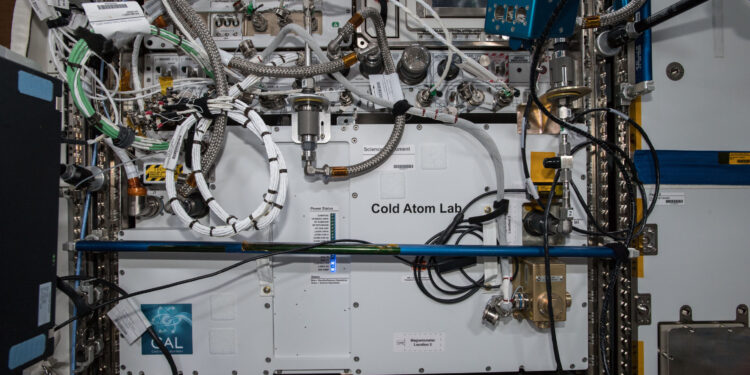NASA’s Cold Atom Laboratory aboard the International Space Station recently demonstrated a tool called an atom interferometer that can precisely measure gravity and other forces, and has many potential applications in space. Credit: NASA/JPL-Caltech
NASA’s Cold Atom Laboratory, a first-of-its-kind facility aboard the International Space Station, has taken another step in revolutionizing how quantum science can be used in space. Science team members measured subtle vibrations in the space station with one of the laboratory’s onboard tools. This is the first time ultracold atoms have been used to detect changes in the environment in space.
The study, published in Nature Communications August 13 also reported the longest demonstration of the wave nature of atoms falling freely in space.
The Cold Atom Lab science team made their measurements using a quantum tool called an atomic interferometer, which can precisely measure gravity, magnetic fields, and other forces. Scientists and engineers on Earth use the tool to study the fundamental nature of gravity and advance technologies that help planes and ships navigate. (Cell phones, transistors, and GPS are just a few of the other major technologies that are based on quantum science but don’t involve atomic interferometry.)
Physicists are eager to apply atom interferometry in space because microgravity allows for longer measurement times and greater instrument sensitivity, but the extremely sensitive equipment has been considered too fragile to operate for extended periods without assistance. The Cold Atom Lab, which is operated remotely from Earth, has now shown that it is possible.
“Reaching this milestone has been an incredible challenge, and our success has not always been guaranteed,” said Jason Williams, Cold Atom Lab project scientist at NASA’s Jet Propulsion Laboratory in Southern California. “It took dedication and a sense of adventure for the team to get there.”
The power of precision
Space sensors that can measure gravity with high precision have a wide range of potential applications. For example, they could reveal the composition of the planets and moons in our solar system, as different materials have different densities that create subtle variations in gravity.
This type of measurement is already being carried out by the German-American collaboration GRACE-FO (Gravity Recovery and Climate Experiment Follow-on), which detects slight changes in gravity to track the movement of water and ice on Earth. An atom interferometer could provide additional precision and stability, revealing more details about mass changes on the surface.
Precise measurements of gravity could also shed light on the nature of dark matter and dark energy, two great cosmological mysteries. Dark matter is an invisible substance five times more common in the universe than the “ordinary” matter that makes up planets, stars, and everything else we can see. Dark energy is the name given to the unknown engine driving the accelerated expansion of the universe.
“Atom interferometry could also be used to test Einstein’s theory of general relativity in new ways,” said Cass Sackett, a professor at the University of Virginia, principal investigator of the Cold Atom Lab and co-author of the new study. “It’s the basic theory that explains the large-scale structure of our universe, and we know there are aspects of it that we don’t understand. This technology could help fill in those gaps and give us a more complete picture of the reality we live in.”
Atomic interferometer installed on board the ISS. Credit: Nature Communications (2024). DOI: 10.1038/s41467-024-50585-6
A portable laboratory
About the size of a mini-fridge, the Cold Atom Lab was launched aboard the space station in 2018 with the goal of advancing quantum science by placing a long-term facility in the microgravity environment of low Earth orbit. The lab cools atoms to near absolute zero, or minus 459 degrees Fahrenheit (minus 273 degrees Celsius).
At this temperature, some atoms can form a Bose-Einstein condensate, a state of matter in which all atoms share essentially the same quantum identity. As a result, some of the typically microscopic quantum properties of atoms become macroscopic, making them easier to study.
Quantum properties sometimes include solid particle behaviors and sometimes waves. Scientists don’t know how these building blocks of all matter can switch between such different physical behaviors, but they’re using quantum technology like that available at Cold Atom Lab to find answers.
In microgravity, Bose-Einstein condensates can reach colder temperatures and exist longer, giving scientists more opportunities to study them. The atom interferometer is one of several tools at the facility that can make precision measurements by exploiting the quantum nature of atoms.
Because of its wave-like behavior, an atom can travel along two physically distinct paths simultaneously. If gravity or other forces act on these waves, scientists can measure this influence by observing how the waves recombine and interact.
“I expect that space-based atom interferometry will lead to exciting new discoveries and fantastic quantum technologies that impact everyday life, and transport us into a quantum future,” said Nick Bigelow, a professor at the University of Rochester in New York and principal investigator of the Cold Atom Lab for a consortium of American and German scientists who co-authored the study.
More information:
Jason R. Williams et al., Pathfinder experiments with atom interferometry in the Cold Atom Laboratory aboard the International Space Station, Nature Communications (2024). DOI: 10.1038/s41467-024-50585-6
Quote: NASA shows off ‘ultra-cool’ quantum sensor in space for first time (August 13, 2024) Retrieved August 14, 2024 from
This document is subject to copyright. Apart from any fair dealing for the purpose of private study or research, no part may be reproduced without written permission. The content is provided for informational purposes only.



